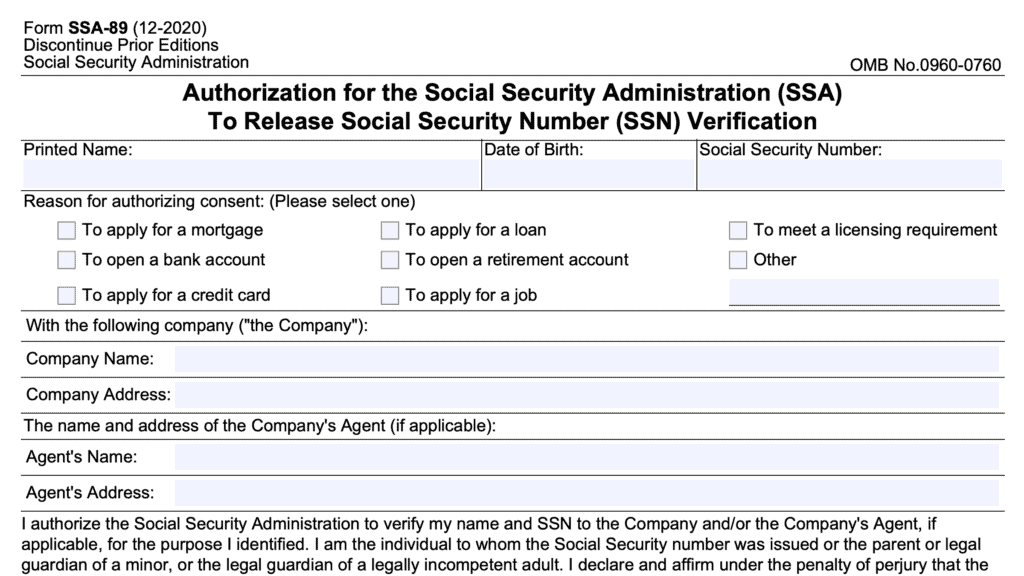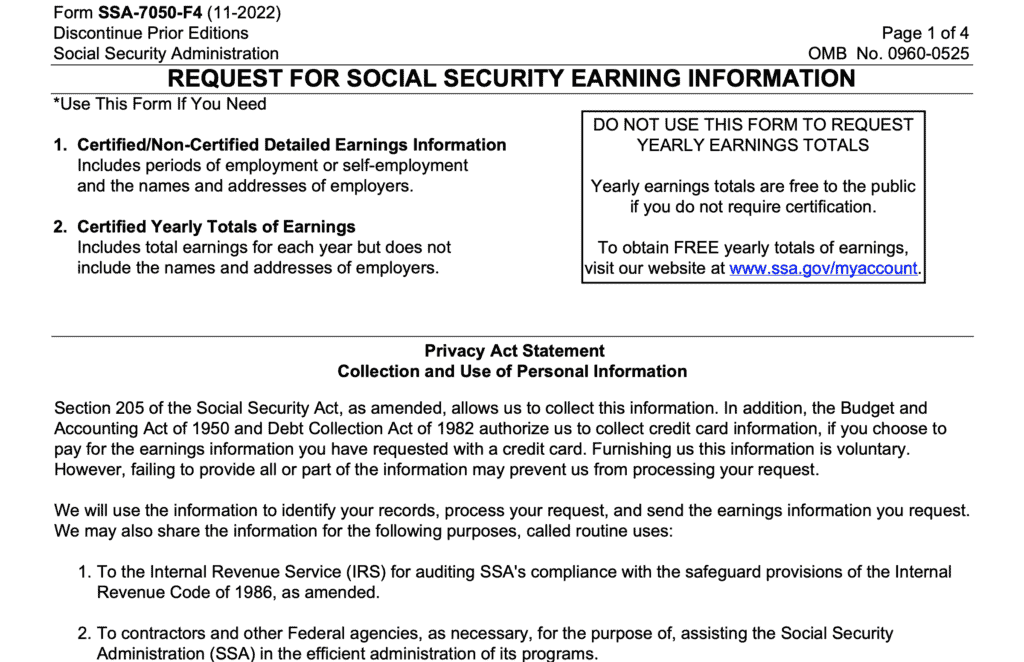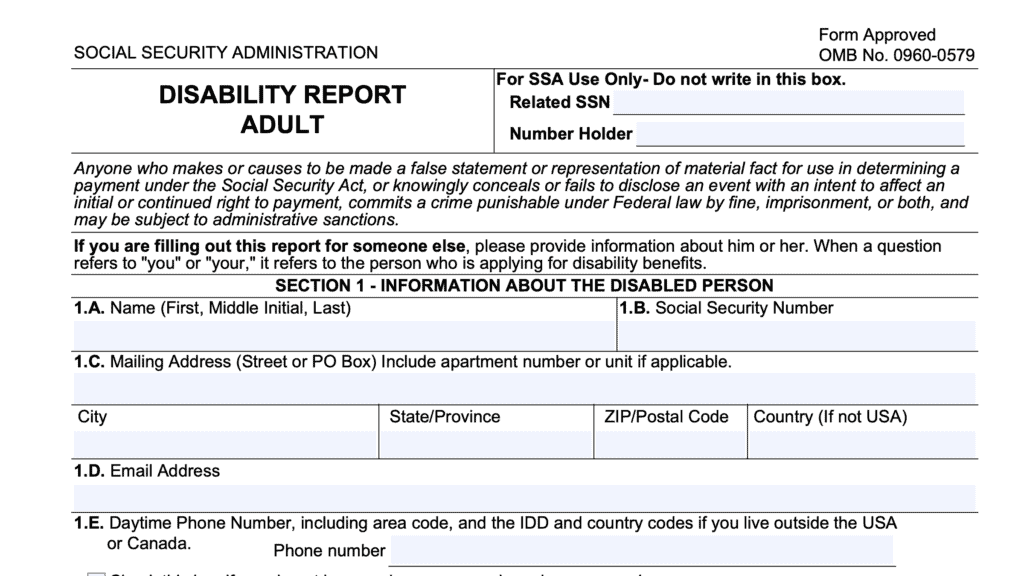Form SSA 16 Instructions
If you’re unable to continue working as a result of a medical condition, illness, or injury, you may be able to file for Social Security disability benefits using Form SSA 16. In this article, we’ll walk through this application form and answer some commonly asked questions about the SSA’s disability claims process.
Let’s start by walking through this form, step by step.
Table of contents
How do I complete Form SSA-16?
According to the form instructions, it should take you about 20 minutes to complete this form. Let’s get started.
Line 1: Name
In Line 1, enter your current name in full: first name, middle initial, and last name.
Line 2: Social Security number
For Line 2, enter your complete Social Security number.
Line 3: Gender
Check the appropriate box.
Line 4: Preferred language
If English is your preferred language, skip Line 4 and proceed to Line 5. If Spanish is your preferred language, you may be able to use the Spanish version of Form SSA-16 to file for disability benefits.
For all others, enter your preferred language in Line 4.
Line 5
In 5a, enter your date of birth. In Line 5b, enter the city and state where you were born. If you were born overseas, list the country where you were born.
Line 6: Citizenship status
If you are a U.S. citizen, check ‘Yes’ to Line 6a, then proceed to Line 7.
For lawfully resident aliens, check ‘No’ to Line 6a, ‘Yes’ to Line 6b, then enter the date of your lawful arrival in the United States in Line 6c.
If neither apply to you, then check ‘No’ to both questions and proceed to Line 7.
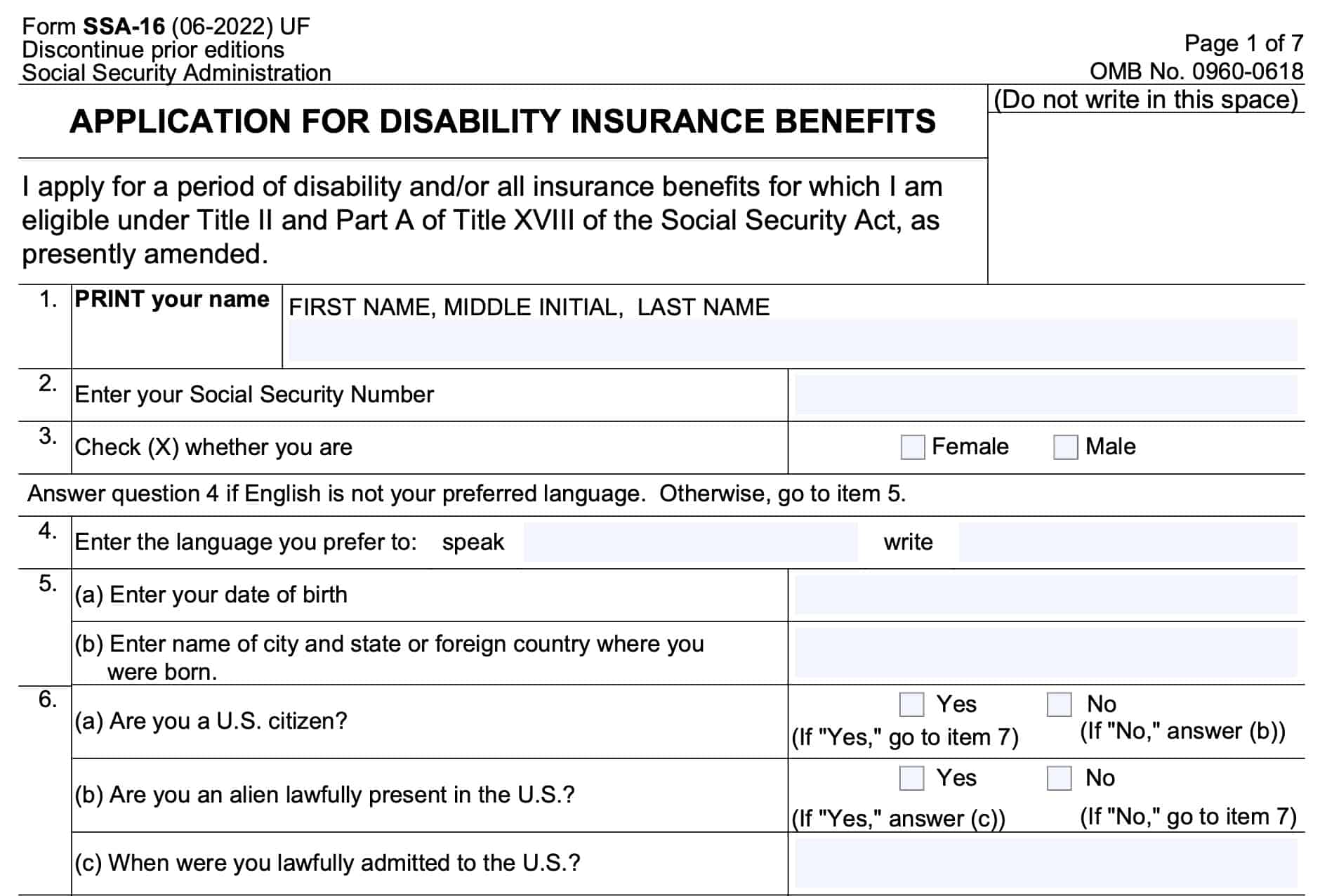
Line 7
If your name is different from the name stated on your birth certificate, then enter your birth name in Line 7a.
If you’ve had any name changes, or used other names or aliases, then answer ‘Yes’ in Line 7b, and answer 7(c). Otherwise, select ‘No’ and proceed to Line 8.
Line 8
If you’ve used another Social Security number for any reason, then answer ‘Yes’ to Line 8a, and enter the SSN (or SSNs) that you’ve previously used. If not, then answer ‘No,’ then go to Line 9.
Line 9
Enter the date where you believe that your health condition began to impact your ability to participate in work-related activities. Answer this question even if you’ve never worked outside the home.
Line 10
If you, your current spouse, or a prior spouse, worked in the railroad industry for at least 5 years, select ‘Yes.’ Otherwise, select ‘No.’
Line 11
If you have Social Security credits from another country’s Social Security program, then select ‘Yes’ and list the country or countries in Line 11b. Otherwise, select ‘No.’
Line 12
If you are eligible for, or expect to be eligible for, a pension, annuity, or lump sum in lieu of a pension or annuity, based on work not covered by Social Security, then select ‘Yes,’ and answer Lines 12b and 12c. Otherwise, select ‘No’ and proceed to Line 13.
In Line 12b, enter the date when you became entitled, or expect to become entitled to this benefit.
In Line 12c, enter the date when you became eligible, or expect to become eligible to this benefit.
Dates of eligibility and entitlement are probably determined by the pension provider, not the Social Security Administration. You may need to review your pension’s eligibility rules to understand these dates.
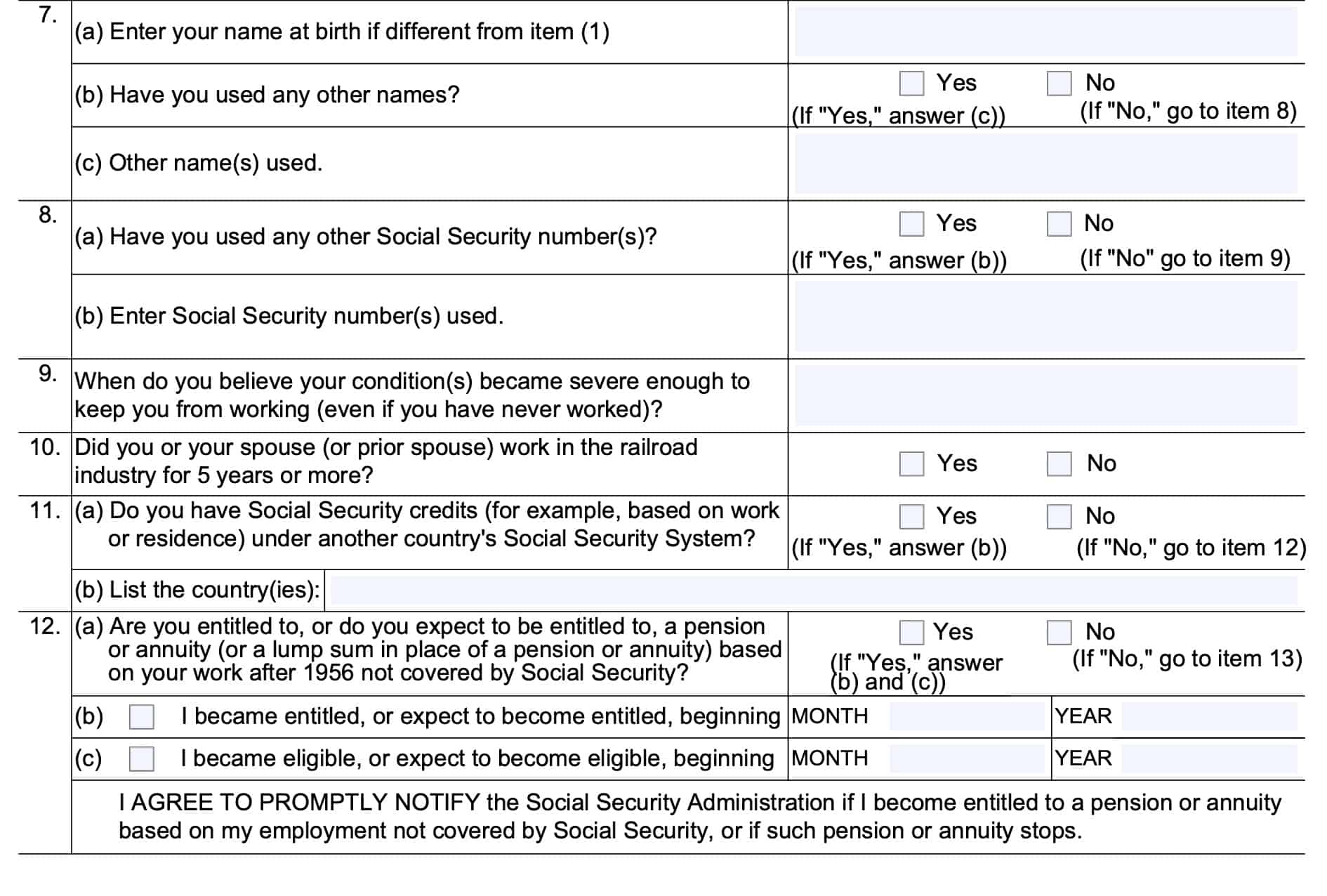
Line 13: Marriage information
Line 13a
In Line 13, you’ll answer marriage related questions. If you’ve never been married, then answer ‘No’ to Line 13a, and proceed to Line 14. Otherwise, enter ‘Yes,’ and move to Line 13b.
Line 13b
In Line 13b, if you are currently married, then enter the following information as it might appear on your marriage license, then proceed to Line 13c:
- Spouse’s name, including maiden name
- Date of marriage
- Where you were married
- Whether the marriage was performed by a clergyman, public official, or another person
- Spouse’s date of birth and Social Security number
If you’re no longer married, then enter ‘None’ on Line 13b, then proceed to Line 13c.
Line 13c
In Line 13c, determine whether you have had any previous marriage that meet any of the following criteria:
- Marriage lasted at least 10 years
- Marriage ended due to the death of your spouse, regardless of length
- Any situation in which you were married, divorced, then remarried within the year following the year of divorce, as long as the combined marriage lasted 10 years or more.
If there are no such previous marriages, list ‘None,’ then proceed to Item 13d. Otherwise, enter the following information:
- Spouse’s name, including maiden name
- Date of marriage
- Where you were married
- Whether the marriage was performed by a clergyman, public official, or another person
- Spouse’s date of birth and Social Security number
- How the marriage ended
- Date of spouse’s death, if applicable
Line 13d
In Line 13d, enter information about any marriage if you:
- Have a child (or children) under age 16, or disabled, or handicapped (disability began before age 22),
- Were married for less than 10 years to the other parent, now deceased, and
- The marriage ended in divorce
If no such marriages exist, write ‘None.’ Otherwise, enter the following information:
- Spouse’s name, including maiden name
- Date of marriage
- Where you were married
- Whether the marriage was performed by a clergyman, public official, or another person
- Spouse’s date of birth and Social Security number
- Date and location of divorce
- Date of spouse’s death
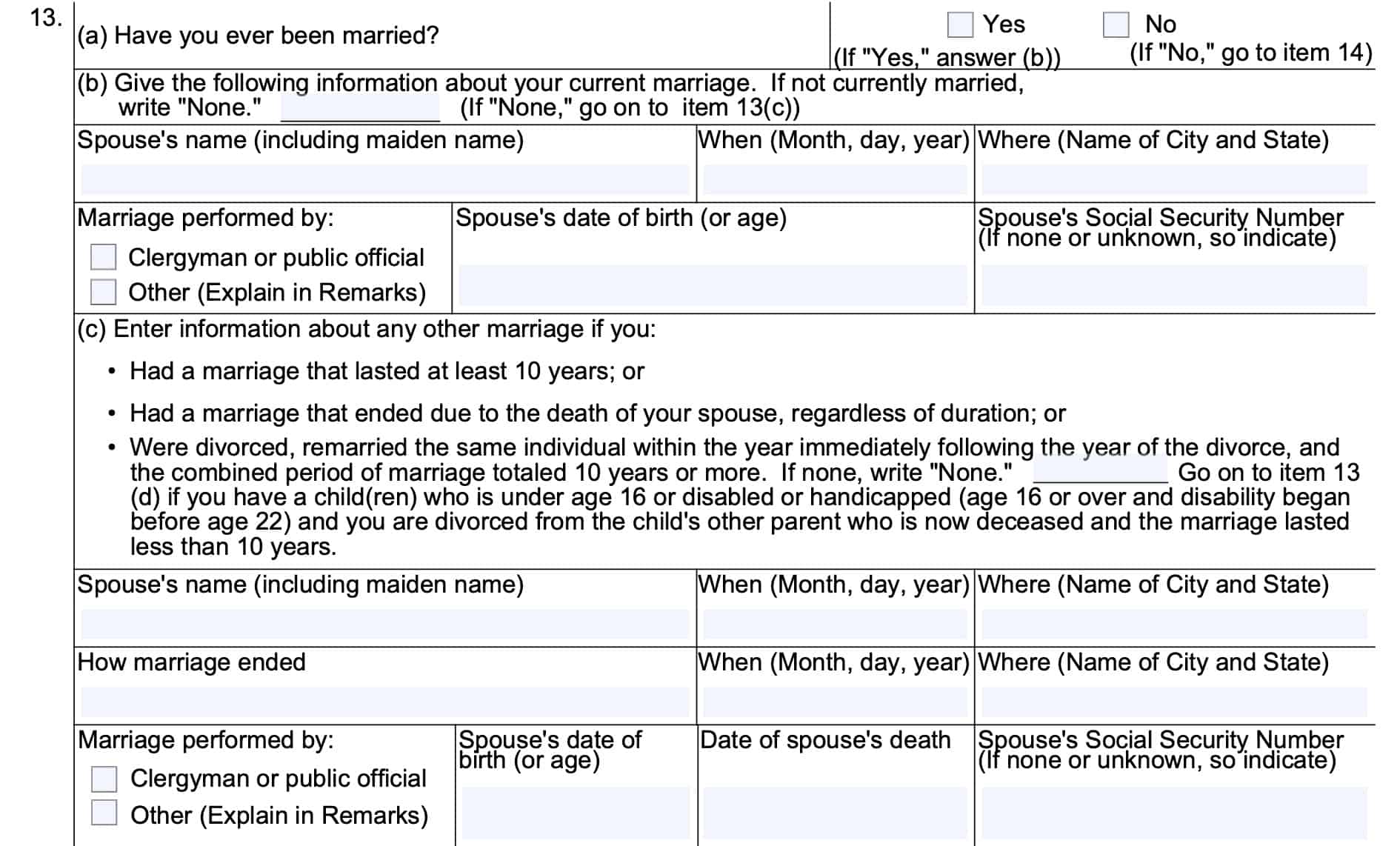
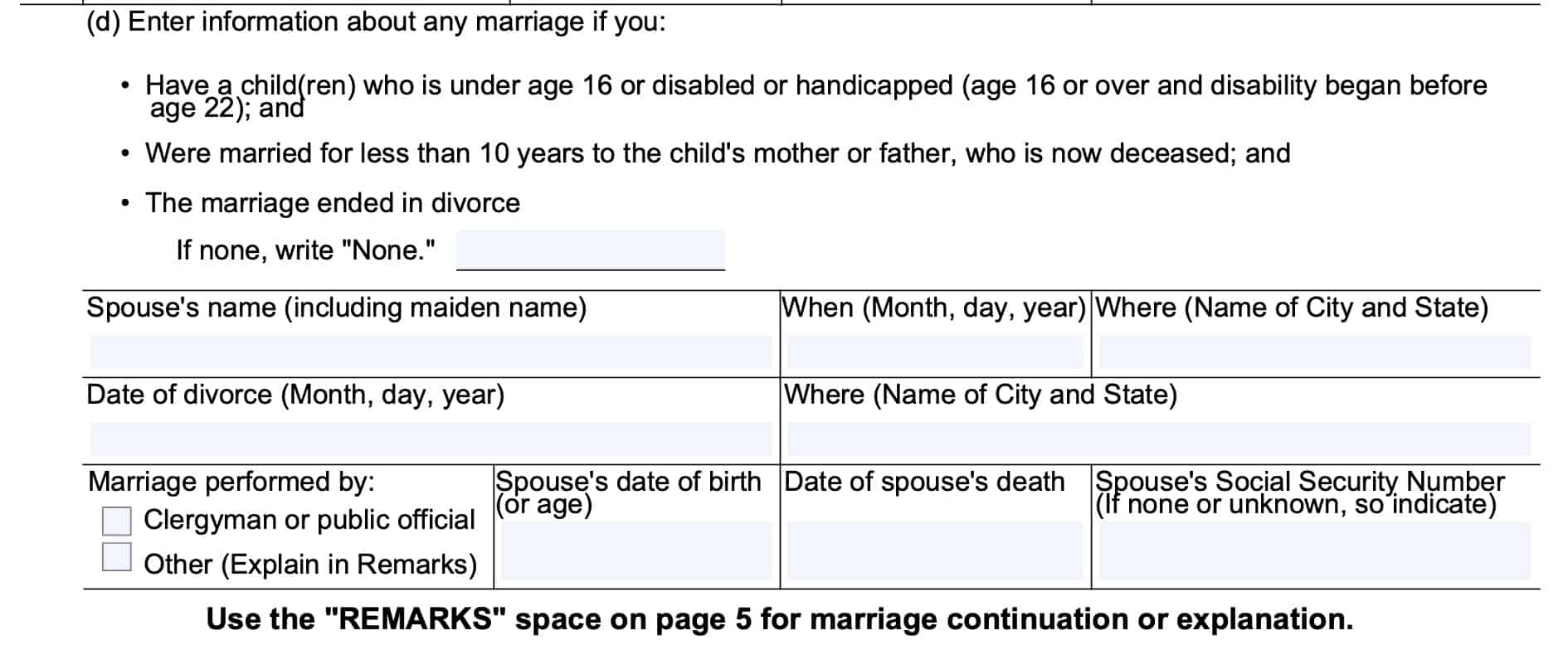
Line 14: Children eligible for benefits
Your children may be eligible for disability benefits, if your application is approved. In Line 14, enter the full name of all children who are unmarried and who meet one of the following criteria:
- A legal minor (under the age of 18)
- Age 18 or 19, and attending school as a full-time student
- Disabled or handicapped adult whose disability began before the age of 22

Line 15
If you had wages or self-employment income for all years, beginning in 1978, select ‘Yes’ and go to Item 16. Otherwise, select ‘No,’ and list the years in which you did not have wages or self-employment income in Line 15b.
Line 16
List the following information for all employers you have worked for in the current year and in the previous year, starting with the most recent employer:
- Employer name
- Employer address
- Month and year that you began working for the employer
- Month and year your employment ended
If you are still working, you may enter, ‘Not Ended’ instead of month/year. If you have not worked for any employer, either in the current year or last year, answer ‘NONE’ and go to Item 17.
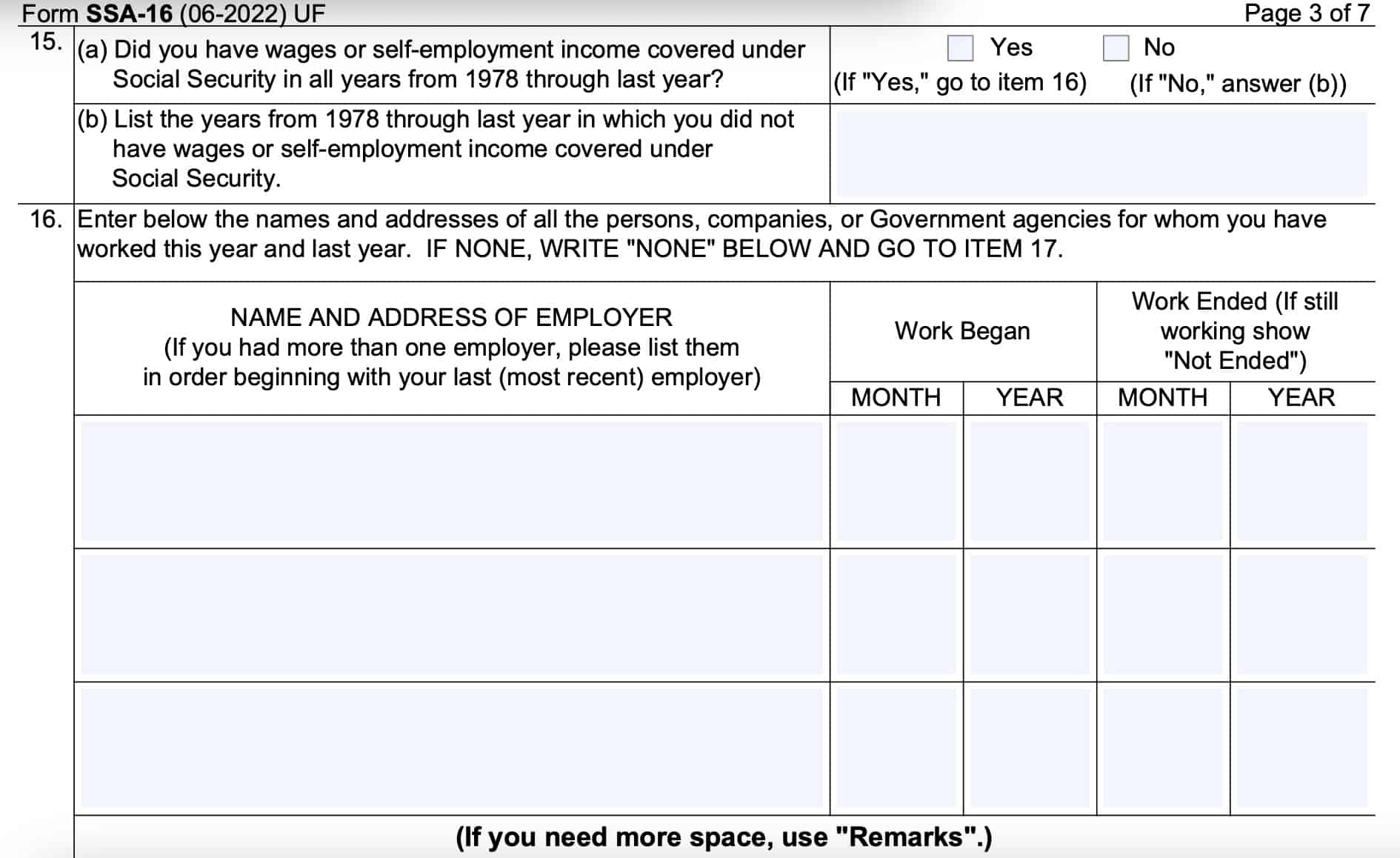
Line 17
Answer Line 17, even if you were an employee.
If you were self-employed in the current year or previous year, answer ‘Yes,’ then proceed to Line 17b. Otherwise, select ‘No,’ and go to Line 18.
In Line 17b, enter the type of trade or business in which you were self-employed, and check ‘Yes’ or ‘No’ regarding whether your net income was $400 or greater.
Line 18
In Line 18a, enter how much of last year’s total earnings were from either wage income or self-employment income. If the answer is $0, enter ‘None.’
In 18b, enter how much you’ve earned in the current year from wage or self-employment income.
Line 19
If you are still unable to work because of illnesses, injuries, or other medical conditions, select ‘Yes’ and proceed to Line 20. Otherwise, enter ‘No’ and enter the date you became able to work in Line 19b.
Line 20
Answer ‘Yes’ or ‘No’ regarding whether your injuries, illnesses, or conditions are related to your employment or occupation in any manner.
Line 21
If you are blind or have low vision (even with glasses or contacts), select ‘Yes.’ Otherwise, select ‘No.’
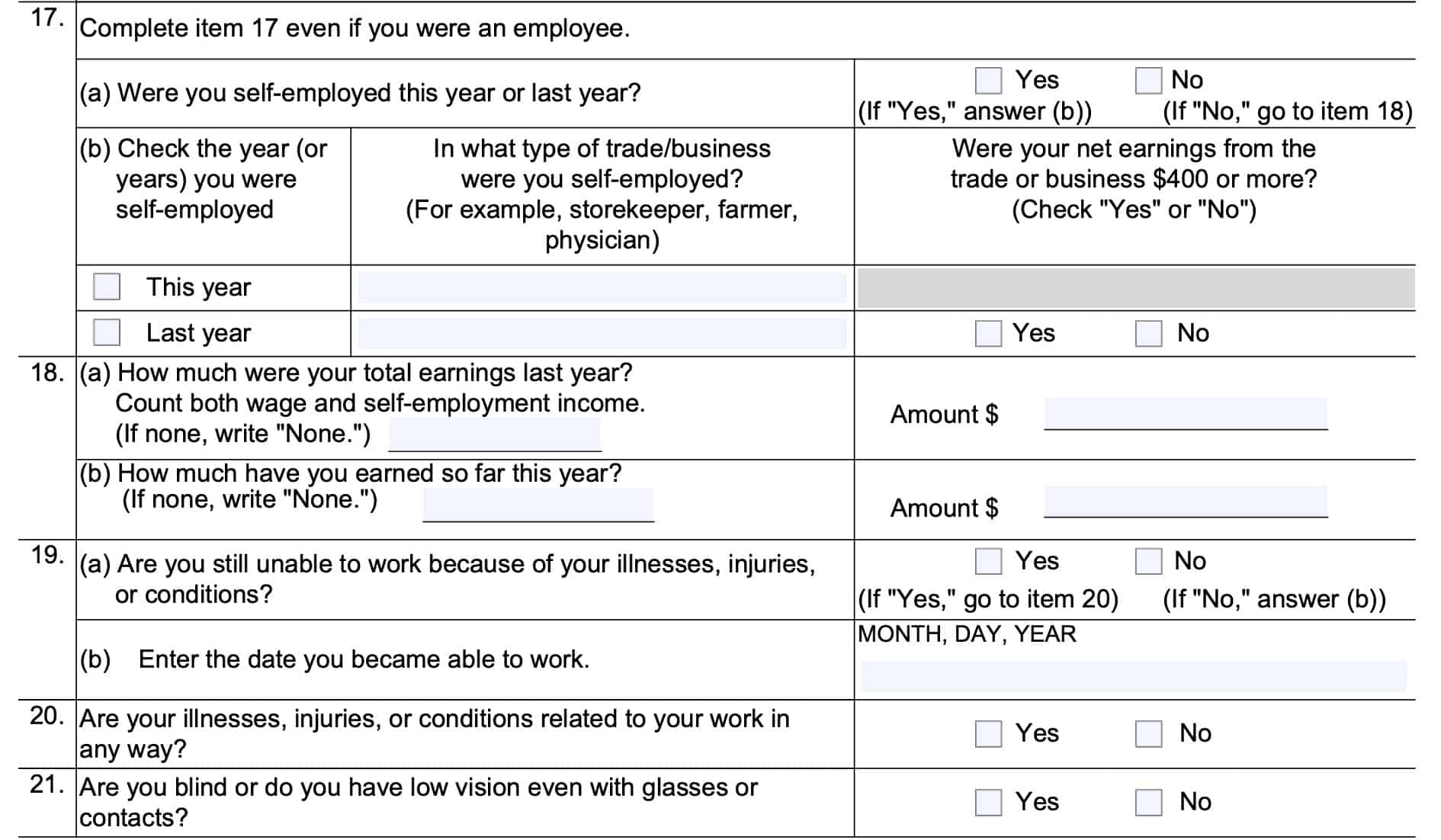
Line 22
If you have ever filed, or if you intend to file for another public disability program, such as workers’ compensation, veteran’s benefits, or supplemental security income (SSI), check ‘Yes’ to Item 22a, then check the appropriate box in 22b. Otherwise, check ‘No,’ then proceed to Line 23.
If you select ‘Other’ public disability benefits, then you must complete a Worker’s Compensation/Public Disability Benefit Questionnaire, also known as Form SSA-546, and include that completed form with your application.
Line 23
If you’ve ever received money from an employer on or after the date indicated in Line 9, check ‘Yes,’ and enter the amount received in Line 23a. Given a written explanation in the Remarks section. Otherwise, go to 23b.
In Line 23b, answer whether you expect to receive additional payments from an employer. If so, annotate how much you expect to receive, and provide any additional information in the Remarks section.
Line 24
If you had a child, under the age of 3 years old, living with you in at least one calendar year when you did not have earned income, then select ‘Yes.’ Otherwise, select ‘No.’
The child can belong to either yourself, your spouse, or both of you.
Line 25
If you had a dependent parent, receiving more than 50% of their support from you, when you became unable to work, then select ‘Yes,’ and enter the following information in the Remarks section:
- Parent’s name
- Parent’s SSN
- Address
If not, select ‘No,’ then go to Line 26.
Line 26
Were you unable to work before the age of 22 because of an illness, injury, or condition? If so, do you have a parent or grandparent who is receiving Social Security retirement benefits, Social Security disability insurance payments, or who is deceased? If the answer is yes, then check the appropriate box and enter the name(s) and SSN, if known, in the ‘Remarks’ section.
Select ‘Unknown,’ if you are not sure of the correct answer. Otherwise, select ‘No.’
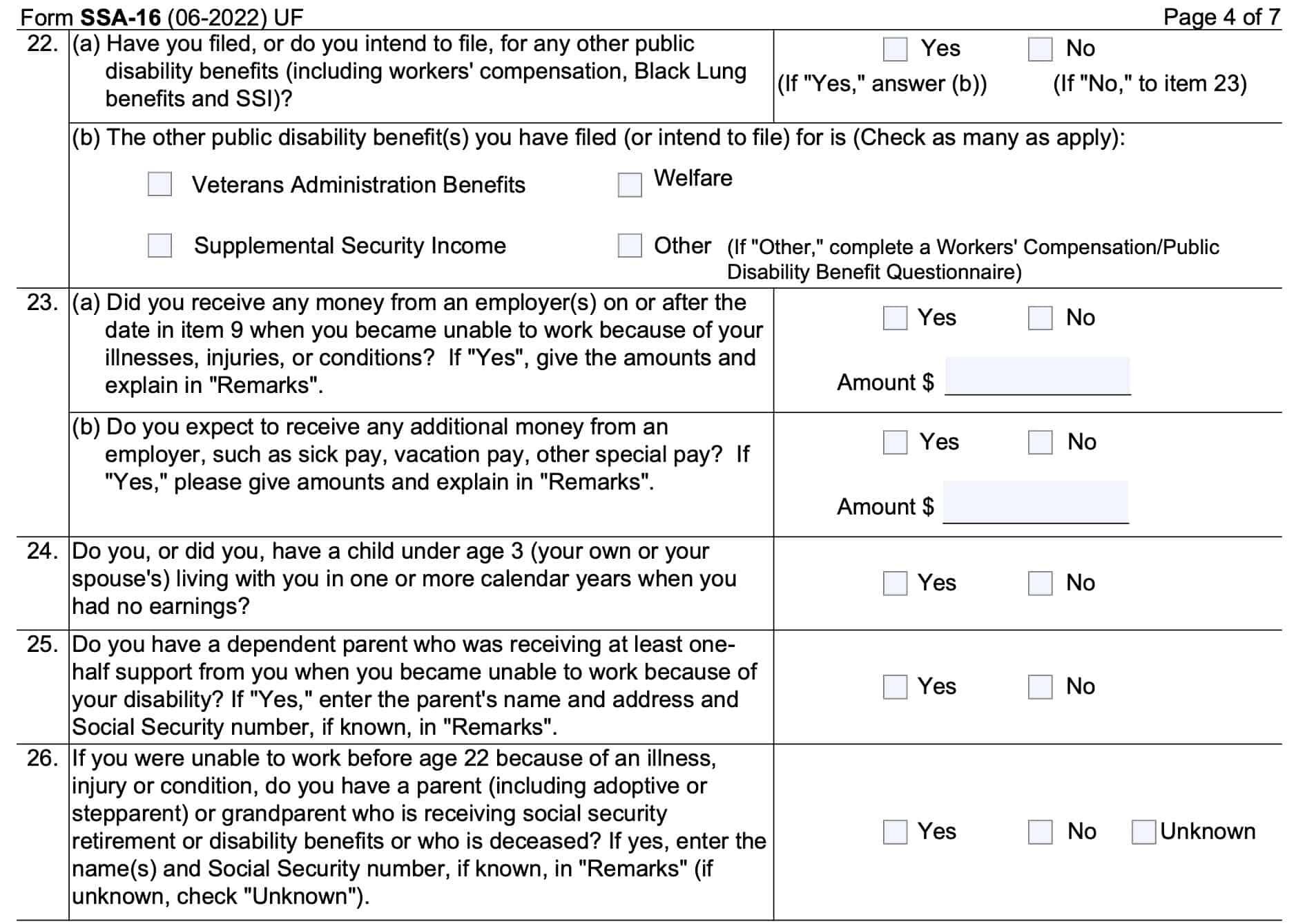
Remarks
The remarks section exists to provide additional space of any written information you may need to provide.
If you use this for more than one question, be sure to clearly annotate which questions your written explanation is addressing.
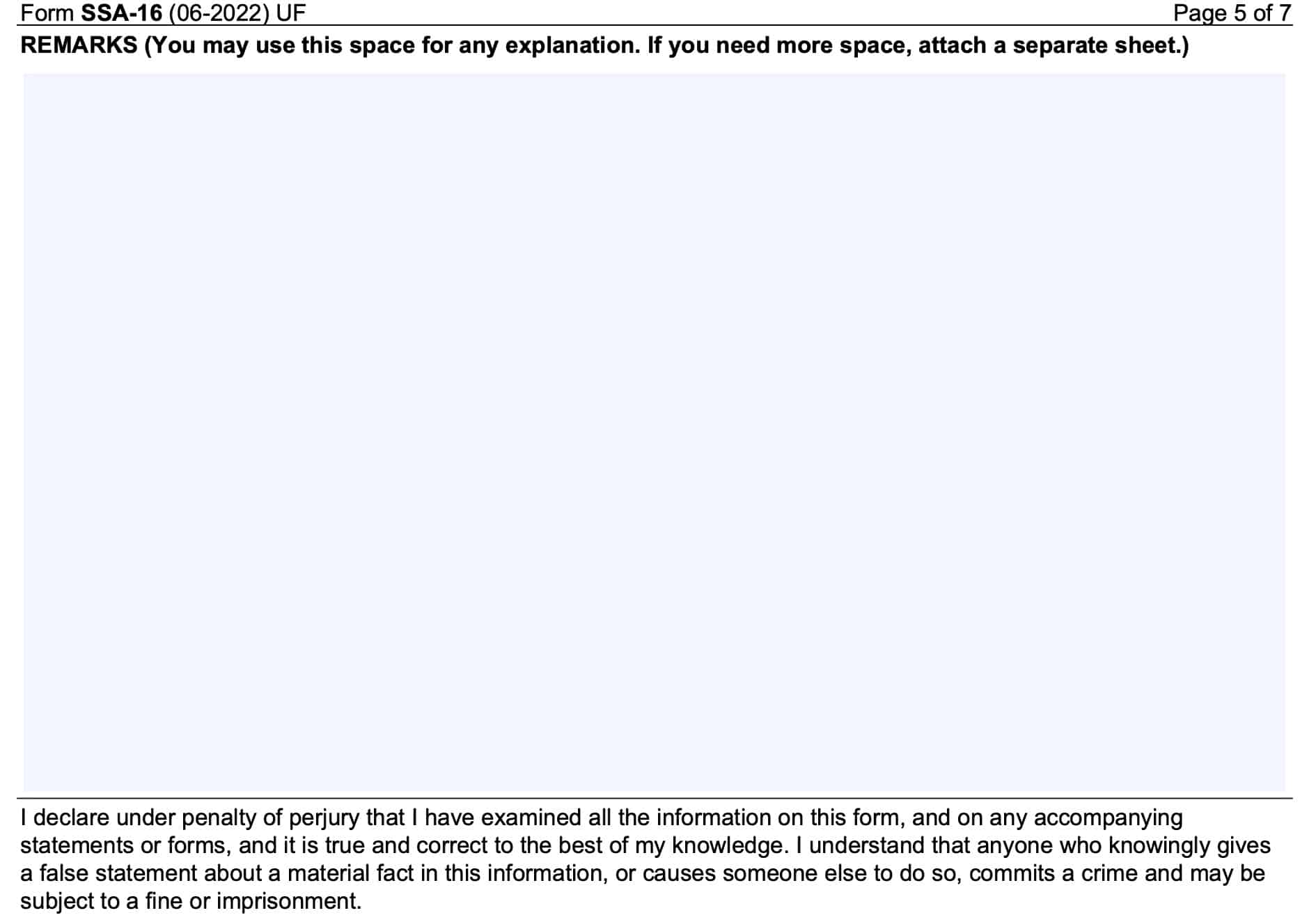
Signature field
In the signature field, you’ll attest, under penalty of perjury, that all submitted information is complete, true, and correct to the best of your knowledge.
Assuming your information is correct, you’ll sign and date the form, and provide your daytime phone number.
Enter your direct deposit information, which consists of:
- Your bank’s routing transit number. This is the 9-digit number unique to each financial institution, and is usually on the left-side of your check book.
- Your account number. This is a unique number for your account, and should be located to the right of your bank’s routing number in your checkbook.
- Whether the account is a checking or savings account
- Whether you’re enrolling in Direct Express, or if you’ve previously had direct deposit refused
Below the payment information, enter your mailing address.
You do not need witnesses to sign this application, unless you place an ‘X’ in the signature field. In this case, you need 2 witnesses who can personally verify your identity.
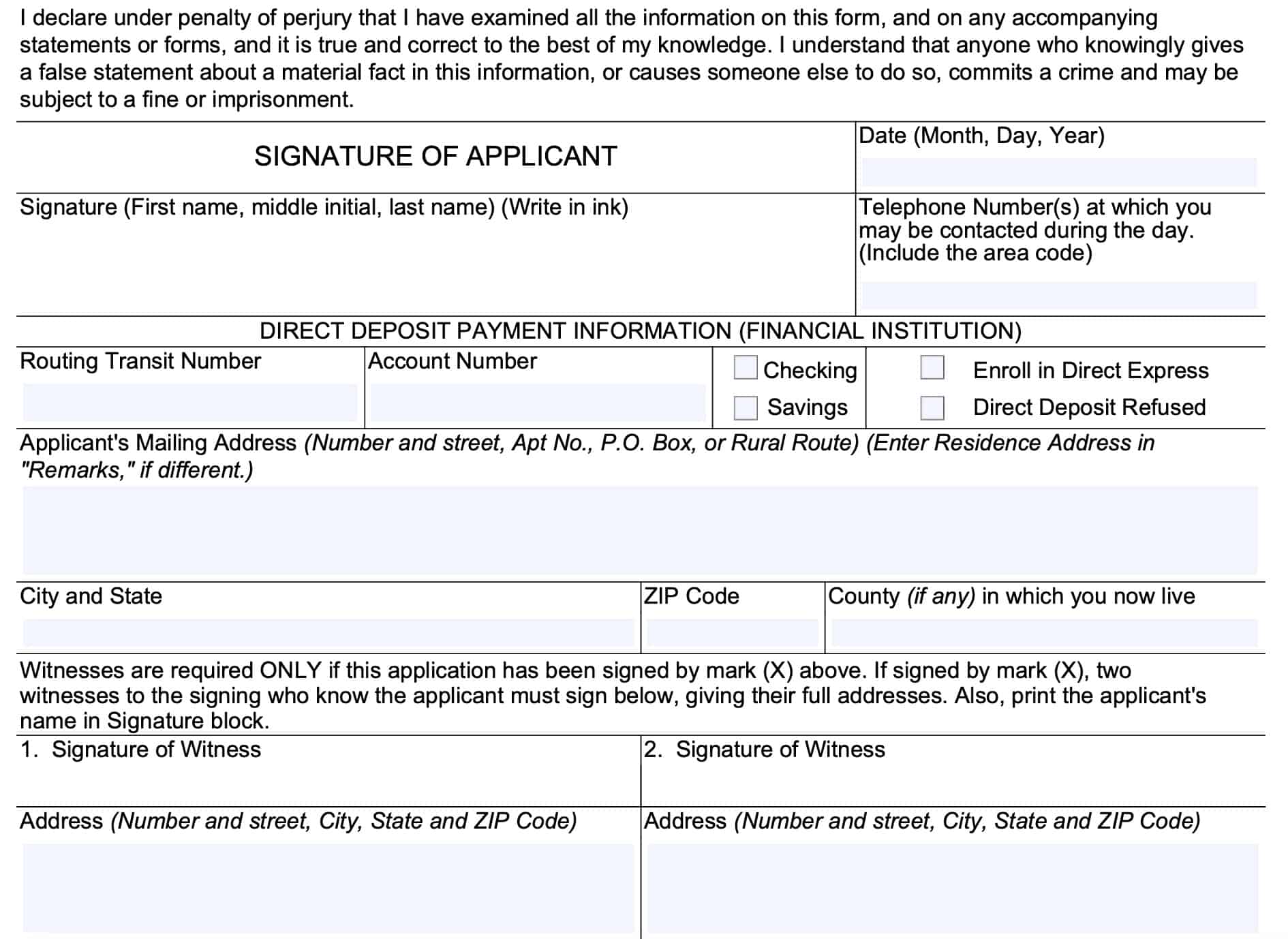
Video walkthrough
Watch this instructional video to learn more about how to file Form SSA-16 and claim your disability benefits.
Frequently asked questions
The SSA evaluates two factors when considering disability benefits. First, the applicant must have worked in jobs eligible for Social Security. Second, the applicant must meet the SSA’s strict definition of disability.
Generally, there is a 5-month waiting period before applicants receive benefits. In general, the Social Security Administration will begin paying disability benefits in the sixth full month after your debilitating medical condition began.
The required documents might depend on your specific situation. However, you’ll need to have identity documents to help establish proof of identity, such as a valid U.S. passport or driver’s license. You’ll also need to provide employment history and access to medical records to verify your disability.
The Social Security administration uses the following criteria for a person to meet its disability guidelines:
-You cannot do work and engage in substantial gainful activity (SGA) because of your medical condition.
-You cannot do work you did previously or adjust to other work because of your medical condition.
-Your condition has lasted or is expected to last for at least 1 year or to result in death.
Where can I find Form SSA 16?
As with other Social Security forms, you may find Form SSA 16 on the SSA.gov website. For your convenience, we’ve enclosed the latest version of the form in this article.

